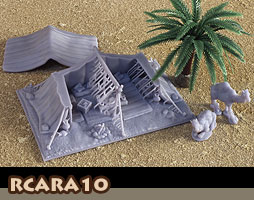|

The basic element of the Bedouin's tent was a long, narrow strip of heavy cloth woven from black (or brown) goat's hair or sheep's wool (not, as many believe, from camel's hair). Several broad strips of cloth were sewn together to form a great rectangle, which became the roof of the tent, supported by poles. Another long narrow strip, the ruaq, was pinned to three sides of the roof of the tent by a series of six-inch wooden pins, then draped to the surface of the ground, where the lower edge was buried in the sand or, if the ground was hard, pegged down. The open side, which always faced away from the wind, was further divided by a number of qata, vertical curtains of intricate design which separated the various sections of the tent. Support for the heavy tent came from long hemp ropes, two affixed to each pole, and three at each side of the tent. The rope-ends were pegged to the ground if the earth was sufficiently hard; otherwise they were tied to large clumps of brushwood and buried two feet beneath the surface of the sand, bracing the tent as firmly as a ship's anchor.
When a Bedouin family moved, the tent was dismantled, rolled up and put on male pack camels. In hot weather the ruaq shielding the sides were rolled up to allow the free circulation of air without admitting sunlight. In cold weather (temperatures on winter nights in some parts of the desert can drop below freezing) the long qata were drawn across the open end of the tent, completely enclosing it, so that the fire kept the occupants cosily warm.
|
|





 Painted samples by Claudio Berni
Painted samples by Claudio Berni


